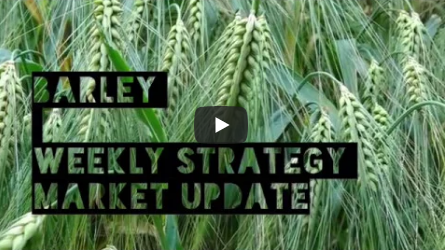From the Grain Industry Association of WA:
BARLEY was the big winner in Western Australia’s grain harvest with an increased production of just over 5.1 million tonnes, up 35.1 per cent on 2017.
In releasing its final crop report for the 2018 harvest last Friday, the Grain Industry Association of Western Australia (GIWA) said WA’s final grain yield for the 2018 season was 17.9mt.
This includes the 16.4mt delivered through the CBH network plus on-farm seed and feed requirements and grain traded outside of CBH.
GIWA confirmed that it was WA’s second biggest harvest ever and the most valuable at just under $7 billion.
The end result is somewhat a surprise for the State.
Earlier predictions of 14mt following the dry spring and several severe frost events were eclipsed by a nearly 4mt turnaround over most parts of WA, due to the late soft finish and mild temperatures during grain fill prior to harvest.
Total tonnage for the Kwinana port zone was up 2.2mt from 2017 and Geraldton port zone was 2mt up from 2017.
The Esperance and Albany port zones were both down from 2017 with a decrease of 0.5mt for Esperance port zone and 0.2mt for the Albany port zones, reflecting the poor growing season in the western and northern areas of the Esperance port zone and the east Albany port zone.
According to the GIWA report, the standout crop in 2018 was barley with an average grain yield of 3.19 tonnes per hectare, well above recent averages.
“The percentage of barley making Malt grades was up by nearly 10pc on historical averages, with a record total tonnage produced of just over 5mt,” it said.
Wheat production was an interesting one to come out of the breakdown with only 54pc of the crop area in WA planted to wheat in 2018, which was the lowest on record.
Despite the low plantings, it was also only the fourth time WA has produced 10mt or more of wheat, with three of those years in the past seven years, including a trend over that time of declining area.
Grain weight was high in most regions of WA, a function of the soft slow finish to the season.
Screenings were generally low except for some very high yielding barley varieties such as Planet when grown on the eastern fringes of the medium rainfall regions.
GIWA said in the southern regions of the State there were reasonable tonnages of Malt grade barley downgraded to feed from germ end stain due to rain and humidity during grainfill and prior to harvest.
Wheat grain protein was lower than in recent years, influenced mainly by the dilution from higher than expected yields.
A noticeable recent trend is that wheat grain protein is more likely to hold up on ameliorated soils where crops are more able to use the available soil moisture “bucket”.
This gives growers more confidence in fertilising for maximum potential.
About 40pc of all barley deliveries made Malt grade which is about 10pc more than normal.
The percentage of Malt grade deliveries were nearly 50pc in the Albany port zone, although this was biased by a greater percentage of feed barley production acquired privately in the zone than other regions of the State.
The late start impacted the amount of canola planted, with programs revised and barley went in to replace canola as the break to the season was delayed.
This meant the canola production of 1.45mt was down 23.7pc from what was produced in the previous year.
Canola oil quality was down slightly from recent years and generally lower than expected by growers considering the soft cool finish to the season.
Most oil percentages were in the mid 40s rather than the high 40s.
Canola grain yields were very erratic in 2018 with no single factor influencing the final result and this may have contributed to average oil percentages being lower than recent years.
Lupin area continues to climb on the back of the more determinate rather than indeterminate growth habit types recently released.
GIWA said “new varieties have more suitable adaptation in the southern areas and whilst producing less growth, are very good yielders for grain”.
The only downside is the prevalence of more split seed in the harvest sample, which appears somewhat to be due to variety, and possibly to higher yields requiring more manganese.
Milling oat demand continues to increase and WA’s reputation for producing a premium product was again enhanced with most milling grade oats delivered or privately acquired of very high grain quality.
Field peas continue to be grown in small quantities in the State’s southern regions.
Many crops were hit by frost and produced low grain yields, although in the absence of frost, grain yields were good.
The smaller areas of lentil, faba bean and chickpea are growing, although GIWA said they were still too small to report on.
In terms of the grain pricing, AgFarm WA regional manager Reid Seaby said the market was pretty lacklustre at the moment.
“The market has been very quiet of late,” Mr Seaby said.
“I think given where cash prices were over the harvest period, most guys would be relatively well sold at this point in time.
“WA pricing has eased slightly and new crop prices have fallen away.
“Wheat supplies globally are starting to run out, which might see export demand shift to Australian and US supplies.
“The government shut down in the US has limited USDA reporting recently, but we should start to get a little more clarity on global trends in the next couple of weeks.
“ASW should be well supported, driven by demand to the Philippines and obviously there is still demand coming from the east coast, so the lower grades will be supported by those two factors I would imagine.
“WA is still competitive globally in terms of barley, but there is no resolution to the China situation in sight, so that is hurting export demand.”
Looking forward Mr Seaby said growers were still assessing programs and waiting for an indication of how the season may play out.
“In terms of forward selling, you look at new crop values compared to old crop and growers were getting $400 a tonne for ANW, if you forward sell at $300 it doesn’t seem that attractive right now,” he said.
“But if you look at historical values, $300/t was the magical figure that everyone tries to start their marketing campaign at, with $400 fresh in their minds, however, $300 looks a little bit soft at the moment.
“I would say consultants would be advising growers to take the emotion out of it and focus on their budget and if $300 works for their figures then the advice may be to start there.”












